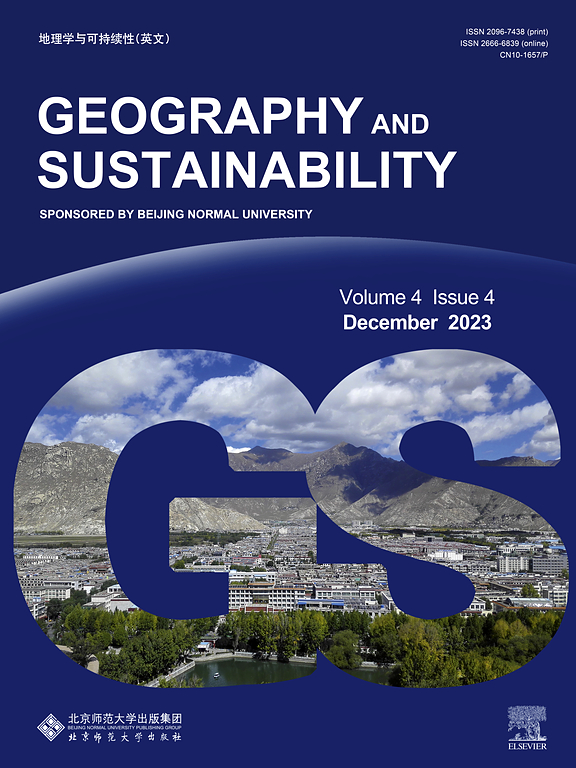提高农业可持续性:优化水-陆-能-经济-环境-粮食关系下的作物种植结构和空间布局
IF 8
1区 环境科学与生态学
Q1 GEOGRAPHY, PHYSICAL
引用次数: 0
摘要
在可持续发展的新阶段,农业正在寻求水-陆-能-经济-环境-粮食关系的可持续管理。目前,考虑自然因素和社会经济因素的作物种植结构优化和空间布局分析研究较少。在此,我们提出了一个解决这一问题的框架。在该框架下,利用NSGA-II算法构建了考虑水能耗、温室气体排放、经济效益以及粮食、土地和水安全约束的作物种植结构多目标优化模型,利用MaxEnt模型和改进的Hungarian算法建立了考虑作物适宜性的作物种植空间布局优化模型。将该框架进一步应用于东北黑土区(BSRNC),分析了不同情景下水稻、玉米和大豆三种主要作物的优化种植结构和空间布局。结果表明,在环境优先情景和经济环境平衡情景下,水稻播种面积分别减少了40.73%和35.30%,大豆播种面积分别增加了112.44%和63.31%。在经济优先情景下,水稻播种面积增加了93.98%。扩大大豆播种面积是减少温室气体排放的有效措施。相反,水稻生产虽然提供了更高的经济回报,但却导致了更大的环境成本。在三种作物中,玉米在平衡环境效益和经济效益方面表现出优势。结果表明,不同情景下,BSRNC东北部鹤岗-鸡西地区是作物转移最强烈的重点地区。总体而言,该框架为考虑各种因素之间的联系,优化作物种植结构和空间布局提供了一种新的方法。通过实例分析,论证了该框架在农业可持续发展和粮食安全保障领域的适用性和推广潜力。本文章由计算机程序翻译,如有差异,请以英文原文为准。

Enhancing agricultural sustainability: Optimizing crop planting structures and spatial layouts within the water-land-energy-economy-environment-food nexus
In the new phase of sustainable development, agriculture is seeking sustainable management of the water-land-energy-economy-environment-food nexus. At present, there are few studies on optimizing crop planting structure and analyzing its spatial layout with consideration of natural and socio-economic factors. Herein, we proposed a framework for addressing this issue. In this framework, the NSGA-II algorithm was used to construct the multi-objective optimization model of crop planting structures with consideration of water and energy consumption, greenhouse gas (GHG) emissions, economic benefits, as well as food, land, and water security constraints, while the model for planting spatial layout optimization was established with consideration of crop suitability using the MaxEnt model and the improved Hungarian algorithm. This framework was further applied in the Black Soil Region of Northeast China (BSRNC) for analyzing optimized crop planting structures and spatial layouts of three main crops (rice, maize, and soybean) under various scenarios. This study showed that the sown area of rice in the BSRNC decreased by up to 40.73 % and 35.30 % in the environmental priority scenario and economic-environmental balance scenario, respectively, whereas that of soybean increased by up to 112.44 % and 63.31 %, respectively. In the economic priority scenario, the sown area of rice increased by up to 93.98 %. Expanding the sown area of soybean was effective in reducing GHG emissions. On the contrary, rice production led to greater environmental costs though it provided higher economic returns. Among the three crops, maize exhibited an advantage in balancing environmental and economic benefits. Hegang-Jixi area in the northeast of the BSRNC was identified as the key area with the most intense crop planting transfer among different scenarios. Overall, this framework provides a new methodology for optimizing crop planting structures and spatial layouts with consideration of the nexus of various factors. Moreover, the case study demonstrates the applicability and expansion potential of the framework in the fields of sustainable agricultural development and food security assurance.
求助全文
通过发布文献求助,成功后即可免费获取论文全文。
去求助
来源期刊

Geography and Sustainability
Social Sciences-Geography, Planning and Development
CiteScore
16.70
自引率
3.10%
发文量
32
审稿时长
41 days
期刊介绍:
Geography and Sustainability serves as a central hub for interdisciplinary research and education aimed at promoting sustainable development from an integrated geography perspective. By bridging natural and human sciences, the journal fosters broader analysis and innovative thinking on global and regional sustainability issues.
Geography and Sustainability welcomes original, high-quality research articles, review articles, short communications, technical comments, perspective articles and editorials on the following themes:
Geographical Processes: Interactions with and between water, soil, atmosphere and the biosphere and their spatio-temporal variations;
Human-Environmental Systems: Interactions between humans and the environment, resilience of socio-ecological systems and vulnerability;
Ecosystem Services and Human Wellbeing: Ecosystem structure, processes, services and their linkages with human wellbeing;
Sustainable Development: Theory, practice and critical challenges in sustainable development.
 求助内容:
求助内容: 应助结果提醒方式:
应助结果提醒方式:


